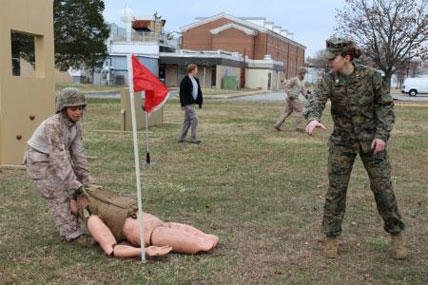MARINE CORPS BASE QUANTICO, Va. - On patrols in Afghanistan and Iraq, Marines must crawl through tight spaces, maneuver steep, uneven stairs and climb through small windows while lugging around weapons and combat gear. But patrols aren’t the only times Marines face these obstacles.
At the Marine Corps Load Effects Assessment Program course —or MCLEAP — Marines maneuver similar obstacles all in the name of improving gear and equipment for the warfighter.
The MCLEAP course was designed based on feedback from Marines about the most common and physically demanding tasks they had to complete in Iraq and Afghanistan, said Mark Richter, Marine Expeditionary Rifle Squad team lead at Marine Corps Systems Command.
The MERS team uses the data they collect through MCLEAP and other sources to make recommendations to Marine Corps requirements and acquisition stakeholders that help improve current and future gear for infantry Marines. MCLEAP helps the team quantify how the weight, stiffness and bulk of Marines’ gear affect their mobility when performing tasks and duties in the field.
“For Marines, mobility is survivability,” Richter said. “We can’t overburden them trying to protect them.”
But mobility is hard to measure, Richter said. That’s where MCLEAP comes in.
The course is built to resemble features Marines encounter in deployed environments like Afghanistan and Iraq. It includes a series of steep and leaning ladders, uneven stairs, window and wall obstacles, and balance beams. The Marines also complete a 200-pound casualty drag and firing exercise to test how the gear affects their performance.
They run the course carrying an M-16 rifle while wearing varying levels of combat gear weighing from about 22 pounds up to 80 pounds, Richter said. This helps the MERS team measure the effects of various gear configurations on the Marines’ mobility and performance. It also tests how the gear moves — or doesn’t move — with the Marines as they change positions or shift directions.
In December, the team tried out a new timing mechanism called the fitLight Trainer to collect data on the speed and agility of Marines moving through the MCLEAP course. The trainer includes lighted sensors located at the end of each obstacle to capture the Marine’s movement as he or she passes. The sensors then send the information to a computer monitored by a MERS team member. The system has been used by professional athletes to test agility and reaction time, but MERS uses it to gain discrete timing data between each obstacle on the course.
The team previously used radio-frequency identification mats that Marines had to step across, but the mats were susceptible to poor weather and not as accurate as the fitLight system, Richter said. With fitLight, Marines only have to pass within five feet of the sensor for it to pick up their movements.
“Additionally, we only had 11 or 12 timing gates with the pressure plates, whereas we have 30 timing gates with the sensors,” Richter said.
The fitLight trainer tells MERS how much the varying levels of gear slow Marines down. They also rely on feedback from Marines to tell them how the gear slows them down.
“Some of the obstacles, like the ones that test footing and balance, are really applicable based on my experience with houses in Iraq,” said 2nd Lt. Zachary Widener, a student at The Basic School on Marine Corps Base Quantico, Va., who ran the MCLEAP course in December. “I think it helps to evaluate gear and see what works and what doesn’t, and where weight encumbers movement. If the gear puts you way off balance, then it’s not something you want to put out in the field.”
The fitLight trainer is one of a few upgrades the MERS team has incorporated into MCLEAP over the last year. They also upgraded two of the obstacles — a 6-foot-high climbing wall and a 10-foot-tall window obstacle. The new obstacles are lighter, easier and safer for the MERS team to disassemble and reassemble, and more durable to withstand the weather, and wear and tear of Marines moving through the course, according to Roger Wood, MERS systems engineer.
The U.S. Army, Australia and Canada also have MCLEAP courses, so ideas for improvements — like using fitLight Trainers — are often a collaborative effort, Wood said.
“Part of the concept behind MCLEAP is if you have multiple nations using it, each nation has the same set up so when we compare data, we’re comparing apples to apples,” he said. “The course is pretty comprehensive, so we only make changes if there is a compelling need to do so.”
MCLEAP is usually stored in standard ISO shipping containers at the MERS Gruntworks facility near The Basic School. Gruntworks is a “workshop” for the MERS team where they conduct human systems integration testing, and even develop prototypes and modifications for existing and emerging Marine infantry equipment.
The MERS team takes MCLEAP on the road to collect data from Marines at other bases in the Continental U.S. and overseas. The more precise the data MERS collects, the better they can advocate for improvements to the gear Marines wear and carry.
“In the coming months, we’ll head out to do more data collection with Marines wearing the plate carrier, [Improved Modular Tactical Vest] and prototype modular scalable vest,” he said. “The feedback we get from the Marines is valuable. We’re making them do things they’ve done during their deployments, but with all their gear on, so it pushes them to the limit. But the data we collect is even more valuable because it [explains] the issues we’re observing as Marines run the course.”



























